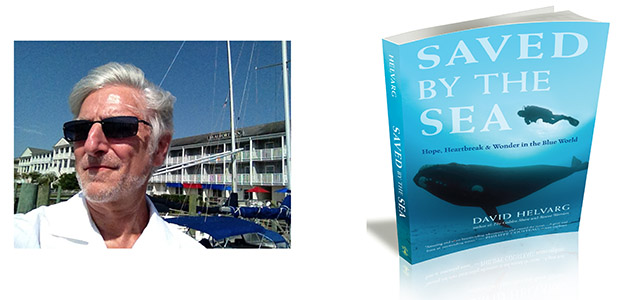The updated paperback edition of local author David Helvarg's Saved by the Sea: Hope, Heartbreak and Wonder in Our Blue World was released by Thomas Dunne Books (an imprint of St. Martin's Press) in April.

David Helvarg
By Paul Duclos
Published: May, 2015
The updated paperback edition of local author David Helvarg’s Saved by the Sea: Hope, Heartbreak and Wonder in Our Blue World was released by Thomas Dunne Books (an imprint of St. Martin’s Press) in April. It is the story of longtime journalist Helvarg’s personal love, loss and redemption in the free-flowing heart of our blue-marble planet.
Here, in an exclusive interview with Cultural Currents, he describes what the book means for Bay Crossings readers.
Bay Crossings: Why will ferry commuters find Saved by the Sea compelling?
David Helvarg: Much of my memoir and certainly some of the most joyous parts of my life have been lived in, on and around the waters of the Bay—from the City, to the ferry terminal at Sausalito and to the future ferry terminal of Richmond, where I now live. My current marina was once Kaiser Shipyard #2, part of World War II’s arsenal of democracy that turned out over 700 Liberty Ships and helped save our blue world thanks to Rosie the Riveter and her workmates. Plus, what’s better on a foggy ferry commute than to read a book that connects you to the everlasting sea around you? Look up and there’s a maritime ballet of container ships, tankers, sailboats, kite-boarders, sea lions and pelicans enveloping you like the marine layer.
BC: Will this sustainable form of transportation become more popular?
Helvarg: Ferries were here before the Bay’s big bridges crowded up and I suspect as a low-cost, energy efficient, safe mode of public transport, they’ll be increasingly popular—both as a way to get around and as new hubs for sustainable waterfront development at new terminal sites. We’re seeing this happen from San Diego to Seattle and Australia to Istanbul. As people reconnect with the waters around them, ferries become ways to both commute and commune with the greater part of our planet that is blue and wet.
BC: The San Francisco Bay Area seems relatively progressive when it comes to environmental concerns; do you feel like this is being threatened by growth?
Helvarg: There are healthy forms of growth and malignant forms of growth. A generation ago the Army Corps of Engineers proposed filling in two-thirds of what was left of San Francisco Bay and turning it into a wide spot in the Sacramento River. People said no and built a movement for coastal and ocean protection that today makes California a world model for living well with the sea—as I wrote in my last book, The Golden Shore. The recent return of harbor porpoises to the Bay after 60 years, the increased presence of river otters and restoration of wetlands in both the South Bay and North Bay—as well as our efforts in Richmond to save Point Molate, a 422-acre natural headlands, from plans to turn it into a mega-casino—reflect the ability of people in our region to understand that a healthy ecosystem assures a healthy economy and way of life. The challenge is not to let short-term greed and short-sighted development threaten our communities both human and wild.
BC: What can average citizens do to keep our seas healthy for future generations?
Helvarg: Everything we do every day impacts the seas around us. Luckily, when we educate ourselves to do right by the seas we tend to do right by ourselves—our pocketbooks, our health and our sense of wellbeing. I wrote the book 50 Ways to Save the Ocean as a guide for how our actions, not just when boating or diving, but our food and energy and civic choices also impact the health of the ocean. Number one is “go to the beach” because we tend to protect the things that we love. And here in Northern California we tend to love coastlines that are rough, wild and cold. Why? Because living on one of the most challenging fetches of ocean on the planet, that’s what we’ve got.
BC: What other books and/or projects do you have planned to address this issue?
Helvarg: My nonprofit Blue Frontier Group (www.bluefront.org) has been working on the fifth Blue Vision Summit and eighth annual Peter Benchley Awards that will take place in Washington D.C. May 11-14. There, hundreds of ocean and coastal leaders from around the nation meet to explore new solutions to the environmental challenges facing our public seas. Among our speakers and honorees this year will be Secretary of State John Kerry, Prince Albert II of Monaco, Senator Brian Schatz of Hawaii, the heads of the U.S. Coast Guard, NOAA and others. We’ll be meeting with our members of Congress to let them know that the ocean matters. Of course, our Bay Area congressional delegation already knows that. Will our work be enough to turn the tide? I don’t know. All I know is if we don’t try we lose, and this salty blue world of ours is too heart-achingly beautiful, scary and sacred to lose. http://paulduclosonsanfranciscoculture.blogspot.com/

